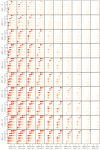Detectability of low-oxygenated regions in human muscle tissue using near-infrared spectroscopy and phantom models
- PMID: 36589557
- PMCID: PMC9774876
- DOI: 10.1364/BOE.473563
Detectability of low-oxygenated regions in human muscle tissue using near-infrared spectroscopy and phantom models
Abstract
The present work aims to describe the detectability limits of hypoxic regions in human muscle under moderate thicknesses of adipose tissue to serve as a groundwork for the development of a wearable device to prevent pressure injuries. The optimal source-detector distances, detection limits, and the spatial resolution of hypoxic volumes in the human muscle are calculated using finite element method-based computer simulations conducted on 3-layer tissue models. Silicone phantoms matching the simulation geometries were manufactured, and their measurement results were compared to the simulations. The simulations showed good agreement with the performed experiments. Our results show detectability of hypoxic volumes under adipose tissue thicknesses of up to 1.5 cm. The maximum tissue depth, at which hypoxic volumes could be detected was 2.8 cm. The smallest detectable hypoxic volume in our study was 1.2 cm3. We thus show the detectability of hypoxic volumes in sizes consistent with those of early-stage pressure injury formation and, consequently, the feasibility of a device to prevent pressure injuries.
© 2022 Optica Publishing Group under the terms of the Optica Open Access Publishing Agreement.
Conflict of interest statement
The authors declare no conflicts of interest.
Figures










Similar articles
-
Numerical Optimisation of a NIRS Device for Monitoring Tissue Oxygen Saturation.Adv Exp Med Biol. 2022;1395:411-416. doi: 10.1007/978-3-031-14190-4_67. Adv Exp Med Biol. 2022. PMID: 36527671
-
Influence of a fat on muscle oxygenation measurement using near-IR spectroscopy: quantitative analysis based on two-layered phantom experiments and Monte Carlo simulation.Front Med Biol Eng. 2000;10(1):43-58. doi: 10.1163/15685570052061531. Front Med Biol Eng. 2000. PMID: 10898475
-
A second-generation virtual-pinhole PET device for enhancing contrast recovery and improving lesion detectability of a whole-body PET/CT scanner.Med Phys. 2019 Sep;46(9):4165-4176. doi: 10.1002/mp.13724. Epub 2019 Aug 7. Med Phys. 2019. PMID: 31315157 Free PMC article.
-
Phantom-based evaluation of near-infrared intracranial hematoma detector performance.J Biomed Opt. 2019 Apr;24(4):1-10. doi: 10.1117/1.JBO.24.4.045001. J Biomed Opt. 2019. PMID: 30989838 Free PMC article.
-
3D conformal MRI-controlled transurethral ultrasound prostate therapy: validation of numerical simulations and demonstration in tissue-mimicking gel phantoms.Phys Med Biol. 2010 Nov 21;55(22):6817-39. doi: 10.1088/0031-9155/55/22/014. Epub 2010 Oct 28. Phys Med Biol. 2010. PMID: 21030751
References
-
- DeVivo M., Farris V., “Causes and costs of unplanned hospitalizations among persons with spinal cord injury,” Top. Spinal Cord Inj. Rehabil. 16(4), 53–61 (2011).10.1310/sci1604-53 - DOI
-
- Jan Y.-K., Crane B. A., Liao F., Woods J. A., Ennis W. J., “Comparison of muscle and skin perfusion over the ischial tuberosities in response to wheelchair tilt-in-space and recline angles in people with spinal cord injury,” Arch. Phys. Med. Rehabil. 94(10), 1990–1996 (2013).10.1016/j.apmr.2013.03.027 - DOI - PMC - PubMed
LinkOut - more resources
Full Text Sources
